As important as the stadium and many of its various parts are to the revival of the ancient games, it is the entrance tunnel that makes the Nemean Games unique. Aside from its architectural significance, it is the passage through the tunnel, clad in chiton and with bare feet, that effects the transformation of the participant from a modern to an ancient. The tunnel thus plays the critical role in the accomplishment of our goal to provide an opportunity for anyone and everyone to become an ancient Greek athlete.
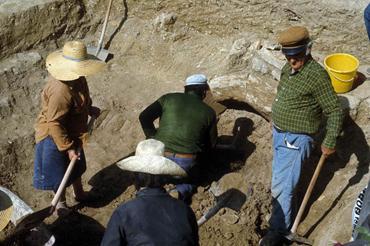
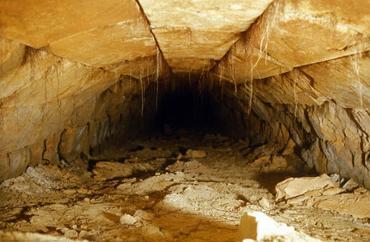
The first look into the tunnel on that day.
On the day that the entrance tunnel was discovered, the first look inside revealed that the center had never been completely filled with earth, and that the surface of the earth was littered with fragments of stone split off from the voussoirs of the vault. But it was also clear that the damage was from the sides and not from the top.
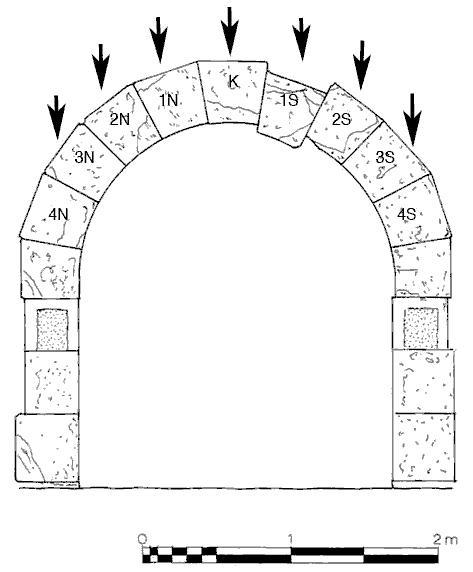
Cross section showing stresses from pressures of earth above tunnel.
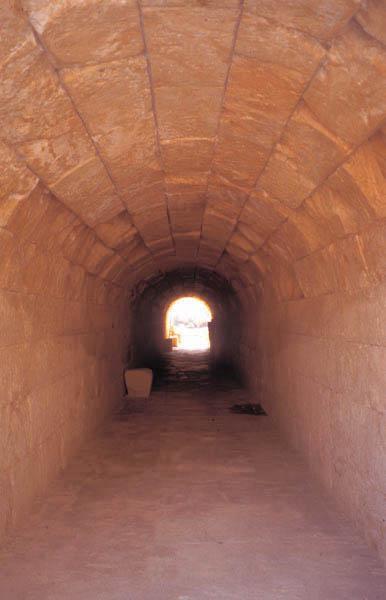
View showing good state of preservation of keystone and neighbouring blocks.
In other words, the keystone and voussoirs 1 to the north and the south of the keystone were in very good condition, whereas voussoirs 2N and 2S showed some damage. But it was in voussoirs 3N and 3S (and to a somewhat lesser extent in 4N and 4S) that the greatest amount of surface damage had occurred. It was therefore certain that the damage was caused by the pressures from the earth fill above the vault which were more or less even over the whole blocks at the center of the vault, but concentrated on the upper interior corner of, for example, 3N by the pressure from 2N.
The ancient builders seem to have been aware of the problem, for the horizontal corners of the blocks were beveled back to provide a relieving surface, but that provision was not adequate.
The problem certainly existed from early in the tunnel’s history for a fragment split from voussoir 3S was found embedded in the floor of the tunnel below the first layer of the earth that was to fill most of the tunnel during the Roman period. The tunnel had existed, however, long enough for a graffito to be scratched on the block before it split. (This fragment, plus a joining piece found nearby, tell us that someone named Aristion was cute.)
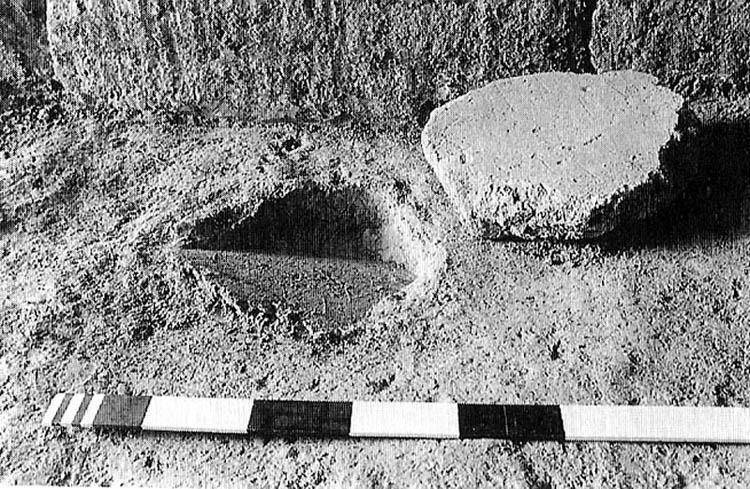
Fragment of voussoir block with ancient grafitto fallen on floor of tunnel.
Since the rear, or exterior, parts of the split blocks were still in place, and since the earth above had stabilized in the 2,300 years since the tunnel’s construction, the tunnel was in no danger of collapse, but in December, 2004, a large fragment fell from a voussoir in the 3N course not far from the west end of the tunnel. It would have injured anyone walking through the tunnel at that time and, therefore, the Archaeological Service closed the tunnel to visitors at that time.
With the tunnel closed, the Fourth Nemead in 2008 could not have taken place, but an agreement was reached in October, 2007, between the Ephor of Antiquities for the Corinthia, Dr. Konstantinos Kissas, and the Society for the Revival of the Nemean Games that the Fourth Nemead might take place with the following three conditions:
- temporary scaffolding would be erected, not in contact with the tunnel, to protect game participants while passing through the tunnel
- a proper study would be made for the ultimate conservation of the tunnel, and
- the conservation would take place and the scaffolding removed in time for the Fifth Nemead in 2012.
Temporary scaffolding was erected, and a meticulous study was then carried out by Dr. Kostas Zambas. That study was approved by the Central Archaeological Council of the Ministry of Culture, and authorized by the Minister of Culture on December 21, 2010.
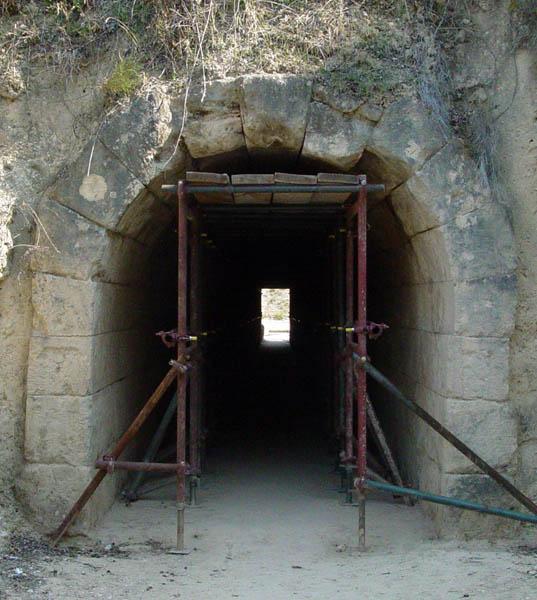
Tunnel from the west with scaffolding to protect visitors, 2008.
The following work was foreseen by the study:
a. Consolidation and gluing together of fragments of stone that are split and ready to fall.
The cracks will be cleaned and sealed followed by the injection of a grout (a mixture of hydraulic lime, pozzolan, and water) into the interior of the cracks and, where needed titanium nails will be inserted. Fallen fragments will be glued back in their original places.
b.Replacements with technical stone.
A few supplements of technical stone will be made in large gaps so that the lost surfaces of the stones will be replaced and will thereby create in certain places «bridges» between the voussoirs and the keystone of the vault. The technical stone will be made of hydraulic lime, brick powder, inorganic coloring agents, and water. Where needed the supplements will be reinforced by titanium rods.
The final result will be, in effect, to create a solid vault with stresses distributed more evenly.
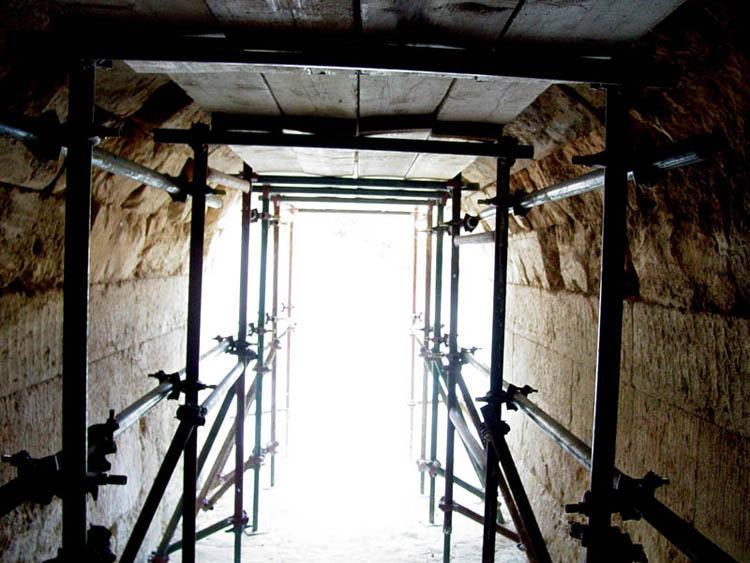
Interior of tunnel looking out through scaffolding toward the west, 2008.
For the work while in progress see Press Release #7 (22 October 2011), and for the final results see Press Release #11 (15 June 2013).
With the work done and the scaffolding gone, the participants in the Fifth Nemead, like those of the first three, passed through the ancient tunnel on their way to the 4th century B.C. The sensation that “I must be entering the Metro”, as a participant in the Fourth Nemead was heard to say, was replaced once again by the ghosts of ancient Greek athletes.